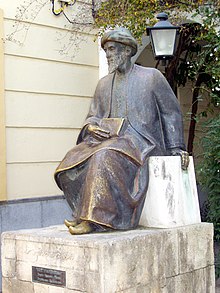יְהוּדֵי סְפָרַד (Yehudei Sfarad) | |
|---|---|
 | |
| Languages | |
| Traditional: Judaeo-Spanish (Ladino), Hebrew (liturgical), Andalusian Arabic, Judaeo-Portuguese, Haketia, Judaeo-Catalan, Judaeo-Occitan, Judaeo-Berber, Judeo-Arabic, Judaeo-Papiamento (in Curaçao) Modern: Modern (Israeli) Hebrew, Sephardi Hebrew (liturgical), Spanish, Portuguese, French, Dutch, Italian, Bulgarian, Greek, Turkish, Persian, other local languages | |
| Religion | |
| Judaism | |
| Related ethnic groups | |
| Mizrahi Jews, Ashkenazi Jews, Hispanic Jews/Latino Jews, other Jewish ethnic divisions, and Samaritans |
Sephardic Jews (Hebrew: יְהוּדֵי סְפָרַד, romanized: Yehudei Sfarad, transl. 'Jews of Spain'; Ladino: Djudios Sefaradis), also known as Sephardi Jews or Sephardim,[a][1] and rarely as Iberian Peninsular Jews,[2] are a Jewish diaspora population associated with the Iberian Peninsula (Spain and Portugal).[2] The term, which is derived from the Hebrew Sepharad (lit. 'Spain'), can also refer to the Jews of the Middle East and North Africa, who were also heavily influenced by Sephardic law and customs.[3] Many Iberian Jewish exiled families also later sought refuge in those Jewish communities, resulting in ethnic and cultural integration with those communities over the span of many centuries.[2] The majority of Sephardim live in Israel.[4]
The earliest documented Jewish presence in the Iberian Peninsula is often traced to the Roman period, during the first centuries CE. After enduring hardship under the Visigoths, Jewish communities thrived for centuries under Muslim rule in Al-Andalus following the Umayyad conquest, which ushered in a golden age. However, their fortunes declined with the Christian Reconquista. In 1492, the Alhambra Decree by the Catholic Monarchs expelled Jews from Spain, and in 1496, King Manuel I of Portugal issued a similar edict for Jews and Muslims.[5] These actions led to migrations, mass conversions, and executions. By the late 15th century, Sephardic Jews had been largely expelled and dispersed across North Africa, Western Asia, Southern and Southeastern Europe, settling in established Jewish communities or pioneering new ones along trade routes like the Silk Road.[6]
Historically, the vernacular languages of the Sephardic Jews and their descendants have been variants of either Spanish, Portuguese, or Catalan, though they have also adopted and adapted other languages. The historical forms of Spanish that differing Sephardic communities spoke communally were related to the date of their departure from Iberia and their status at that time as either New Christians or Jews. Judaeo-Spanish, also called Ladino, is a Romance language derived from Old Spanish that was spoken by the eastern Sephardic Jews who settled in the Eastern Mediterranean after their expulsion from Spain in 1492; Haketia (also known as "Tetuani Ladino" in Algeria), an Arabic-influenced variety of Judaeo-Spanish, was spoken by North African Sephardic Jews who settled in the region after the 1492 Spanish expulsion.
In 2015, more than five centuries after the expulsion, both Spain and Portugal enacted laws allowing Sephardic Jews who could prove their ancestral origins in those countries to apply for citizenship.[7] The Spanish law that offered citizenship to descendants of Sephardic Jews expired in 2019, although subsequent extensions were granted by the Spanish government —due to the COVID-19 pandemic— in order to file pending documents and sign delayed declarations before a notary public in Spain.[8] In the case of Portugal, the nationality law was modified in 2022 with very stringent requirements for new Sephardic applicants,[9][10] effectively ending the possibility of successful applications without evidence of a personal travel history to Portugal —which is tantamount to prior permanent residence— or ownership of inherited property or concerns on Portuguese soil.[11]
Cite error: There are <ref group=lower-alpha> tags or {{efn}} templates on this page, but the references will not show without a {{reflist|group=lower-alpha}} template or {{notelist}} template (see the help page).
- ^ Aroeste, Sarah (13 December 2018). "Latino, Hispanic or Sephardic? A Sephardi Jew explains some commonly confused terms". My Jewish Learning. Archived from the original on 7 August 2020. Retrieved 1 December 2019.
- ^ a b c Aroeste, Sarah (13 December 2018). "Latino, Hispanic or Sephardic? A Sephardi Jew explains some commonly confused terms". My Jewish Learning. Archived from the original on 7 August 2020. Retrieved 1 December 2019.
- ^ Faur, Jose (1 January 2010). The Horizontal Society: Understanding the Covenant and Alphabetic Judaism (Vol. I and II). Academic Studies Press. ISBN 978-1-936235-04-9.
- ^ "Israel: The Askenazi-Sephardic confrontation". cia.gov.
- ^ Fernandes, Maria Júlia (1996). "Expulsão dos judeus de Portugal (Expulsion of Jews from Portugal)" (in Portuguese). RTP. Archived from the original on 20 February 2020. Retrieved 26 July 2018.
- ^ "Sephardi People". Britannica.com. Britannica. Archived from the original on 29 October 2020. Retrieved 1 December 2020.
- ^ "Spanish & Portuguese Citizenship". sephardicbrotherhood. Archived from the original on 29 November 2020. Retrieved 29 November 2020.
- ^ "Ministry of Justice of Spain, Resolución de 13 de mayo de 2020, de la Dirección General de Seguridad Jurídica y Fe Pública". Boletín Oficial del Estado (in Spanish). pp. 34409–34410. Retrieved 29 May 2022.
- ^ "Publicado Decreto-Lei que Altera o Regulamento da Nacionalidade Portuguesa". Alto Comissariado para as migrações (in Portuguese).
- ^ de Vicente de Rojas, Alejandro (22 March 2022). "Amendments to the Portuguese nationality process for Sephardim published". Larrauri & Martí Abogados. Retrieved 7 February 2023.
- ^ "Section 3-d) in Article 24.°-A of Decreto-Lei n.º 26/2022, de 18 de março, que altera o Regulamento da Nacionalidade Portuguesa". Diário da República Eletrónico (in Portuguese). Retrieved 29 May 2022.